Varanasi travel - India, Asia
Varanasi, also known as Benares or Kashi, one of the world's oldest continuously inhabited cities, sits majestically on the banks of the sacred Ganges River in northern India. This spiritual capital of Hinduism captivates visitors with its ancient ghats (riverfront steps) where pilgrims perform rituals, the mesmerizing Ganga Aarti ceremony at dusk, and a labyrinth of narrow alleys filled with temples and bustling bazaars. Travelers flock to Varanasi to witness the cycle of life and death, explore its rich cultural tapestry, and experience the mystical atmosphere that permeates the city. The city is also renowned for its silk weaving, classical music, and flavorful street food, particularly its famous lassi and chaat.
Notable features include the iconic Kashi Vishwanath Temple, dedicated to Lord Shiva, and the famous Ganga Aarti ceremony held at Dashashwamedh Ghat, where visitors can witness the mesmerizing rituals performed in honor of the Ganges. Varanasi is also close to Sarnath, where Buddha delivered his first sermon, adding to its importance as a center for Buddhism.
Population: Estimate 1,800,000 people (as of 2024)
Economy: Silk weaving is the dominant manufacturing industry, with Varanasi famous for its fine silk and Banarasi saris. The city is known for handicrafts like hand-knotted carpets, brassware, copperware, wooden and clay toys, and gold jewelry. Tourism is Varanasi's second most important industry after silk weaving. Over 3 million domestic and 200,000 foreign tourists visit annually, primarily for religious reasons.
Landmarks: Kashi Vishwanath Temple, Dashashwamedh Ghat, Assi Ghat, Manikarnika Ghat, Sarnath, Tulsi Manas Temple, Ramnagar Fort
India
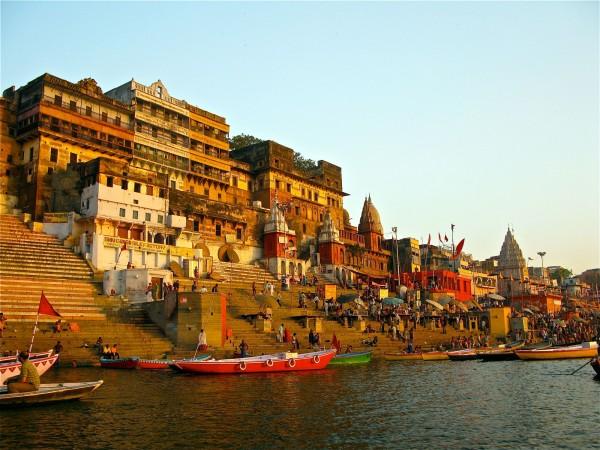
Overview of Varanasi
History & Cultural Influence
Varanasi, also known as Benares or Kashi, is one of the world's oldest continuously inhabited cities, with a history dating back to at least the 11th or 12th century BCE. Its historical significance and cultural influence have profoundly shaped the city's character.
Archaeological evidence suggests early settlement in the Ganga valley around Varanasi began in the 11th or 12th century BCE. The city quickly became a center for religious and philosophical activities, establishing its spiritual importance early on. Varanasi has been a major center of Hinduism for millennia. It's considered one of the seven holiest cities in Hinduism and is believed to grant moksha (liberation from the cycle of rebirth). This has made it a major pilgrimage site, attracting devotees from across India and the world. The city was also significant in the development of Buddhism. Gautama Buddha is said to have given his first sermon at nearby Sarnath in the 6th century BCE.
The city's famous ghats (riverfront steps) and numerous temples, many dating back centuries, reflect its long history and cultural importance. These structures have become iconic symbols of the city.
Interaction with The Locals
When interacting with locals in Varanasi, visitors can expect a vibrant and diverse experience. Varanasi has a population of approximately 1.8 million people, predominantly Hindu with significant Muslim and other minority communities. The city attracts pilgrims and visitors from all over India, creating a diverse mix of cultures and languages.
Locals in Varanasi are generally welcoming and friendly towards tourists. The city's long history as a pilgrimage site and tourist destination has made residents accustomed to interacting with visitors from various backgrounds. Many locals, especially those working in tourism-related sectors, speak some English.

Varanasi overview - © kashi gov
Top attractions in Varanasi
Explore the spiritual heart of India in Varanasi, one of the world's oldest inhabited cities. Wander along the ghats of the Ganges, where you can witness timeless rituals and ceremonies that captivate the essence of Indian spirituality. Don't miss the majestic Kashi Vishwanath Temple, an iconic site dedicated to Lord Shiva, and experience the enchanting evening Ganga Aarti, a ritual that lights up the river with countless lamps, creating a truly magical atmosphere.
Ganges River
Location: Flows through the heart of Varanasi
The Ganges River, revered as a sacred waterway, is the spiritual lifeblood of Varanasi. Visitors can embark on soul-stirring boat rides, immersing themselves in the tranquil yet vibrant atmosphere that encapsulates this holy city.
Dashashwamedh Ghat
Location: Dashashwamedh Ghat Road, Bangali Tola, Varanasi, Uttar Pradesh
As the most lively and celebrated ghat in Varanasi, Dashashwamedh Ghat is renowned for its mesmerizing evening Ganga Aarti ceremony, where elaborate rituals and vibrant music create an unforgettable experience.
Kashi Vishwanath Temple
Location: Lahori Tola, Varanasi, Uttar Pradesh
The Kashi Vishwanath Temple, adorned with a gold-plated spire, stands as a monumental site dedicated to Lord Shiva. This temple is not only a spiritual haven but also a masterpiece of religious artistry, drawing devotees and tourists alike.
Sarnath
Location: Sarnath, Varanasi, Uttar Pradesh (about 10 km northeast of Varanasi)
Sarnath marks the site where Buddha delivered his first sermon, making it a cornerstone of Buddhist pilgrimage. The area is dotted with ancient ruins and the majestic Dhamek Stupa, offering a profound glimpse into Buddhist history and architecture.
Ramnagar Fort
Location: Ramnagar, Varanasi, Uttar Pradesh
Built in the 18th century, Ramnagar Fort is an impressive palace complex that showcases the grandeur of Mughal architecture. Located on the eastern bank of the Ganges, it provides a picturesque backdrop and a historic exploration site.
Assi Ghat
Location: merging point of Assi River and River Ganga, Varanasi, Uttar Pradesh
Assi Ghat, known for its serene environment, is the southernmost of the main ghats. It's a place where one can partake in morning yoga sessions and experience the spiritual calm of evening aartis.
Banaras Hindu University
Location: Banaras Hindu University Campus, Varanasi, Uttar Pradesh
Banaras Hindu University, one of the largest residential universities in Asia, is celebrated not only for its academic excellence but also for its beautiful campus. The university also houses the Bharat Kala Bhavan museum, which features a rich collection of Indian art and artifacts.
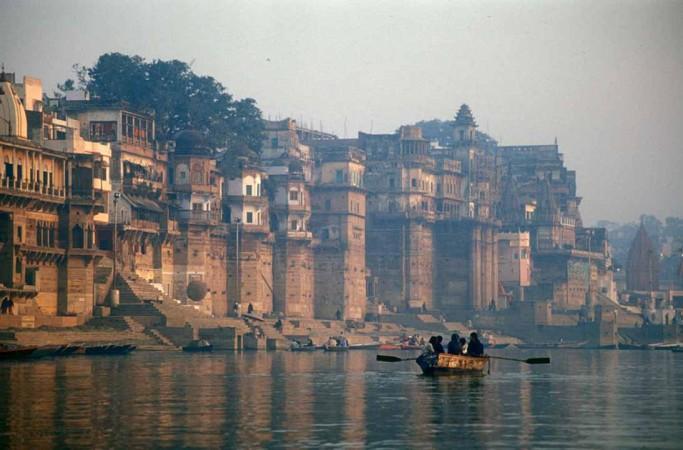
Ganges River - © Babasteve
Must-Try Dishes in Varanasi
Dive into the culinary landscape of Varanasi, where traditional flavors meet rich history. Savor the iconic Kachori Sabzi, a beloved breakfast of spicy curry paired with deep-fried bread, a perfect start to any day exploring the city. Indulge in Malaiyo, a winter delicacy made from frothy milk and saffron, capturing the essence of Varanasi’s sweet tooth. Don’t leave without trying the local Tamatar Chaat, a tangy tomato-based snack that will tantalize your taste buds with its blend of spices and crunchy bits.
Tamatar Chaat
Discover the zesty and spicy Tamatar Chaat, a unique street food specialty from Varanasi. This snack is a vibrant mix of roasted tomatoes, boiled potatoes, and a blend of spices, capturing the city's flair for bold and imaginative chaat creations.
Kachori Sabzi
Kachori Sabzi is a staple breakfast in Varanasi, featuring deep-fried pastry balls stuffed with spiced lentils, paired with a tangy potato curry. This indulgent meal highlights the city's penchant for deep-fried delights and its rich street food culture.
Malaiyo
Known locally as Nimish, Malaiyo is a winter favorite in Varanasi, a light and frothy dessert crafted from milk cream, infused with saffron and cardamom. Prepared in the cool early morning hours, this seasonal treat is cherished during the colder months.
Banarasi Paan
Banarasi Paan, more than just an after-meal refreshment, is a cultural icon of Varanasi. This preparation involves wrapping betel leaves around areca nuts and an assortment of sweet or savory fillings, epitomizing the culinary heritage and social customs of the city.
Choora Matar
Savor the warm and comforting Choora Matar during Varanasi's chilly winters. This breakfast dish blends flattened rice with green peas, ghee, and spices, showcasing how simple ingredients are transformed into satisfying and flavorful meals in Varanasi cuisine.
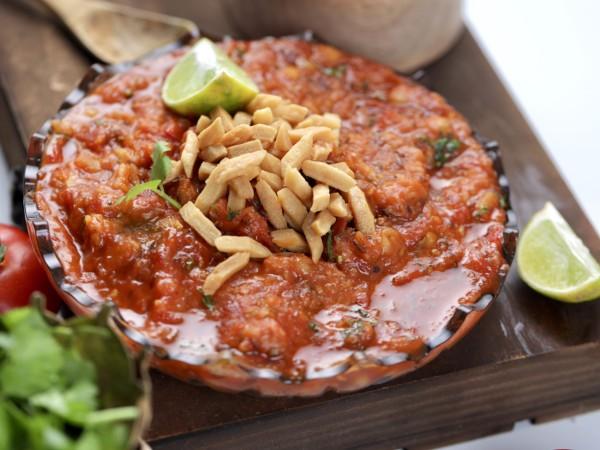
Tamatar Chaat - © gather
Festivals & Local Celebrations
Dev Deepawali
When: 15 days after Diwali (usually in November)
Dev Deepawali, the "Festival of Lights of the Gods," is a breathtaking celebration in Varanasi. Thousands of oil lamps light up the ghats along the Ganges River, creating a mesmerizing sight. The city is vibrant with colors, cultural performances, and special rituals, while boat rides provide stunning views of the illuminated riverfront.
Ganga Mahotsav
When: October/November (15 days before Diwali)
Ganga Mahotsav is a five-day festival that pays homage to the River Ganges. The event features classical music and dance performances by renowned artists at the ghats, highlighting Varanasi's rich cultural heritage and leading up to the grandeur of Dev Deepawali.
Maha Shivratri
When: February/March (14th day of the dark fortnight in Phalguna month)
Maha Shivratri is fervently celebrated in Varanasi, particularly at the Kashi Vishwanath Temple. The festival involves elaborate rituals, processions, and all-night vigils, filling the city with devotional songs and chants of "Om Namah Shivaya."
Bharat Milap
When: October/November (a few days after Dussehra)
Bharat Milap commemorates the reunion of Lord Ram with his brother Bharat after his 14-year exile. This event features elaborate processions and dramatic performances, especially prominent in the Nati Imli area of Varanasi. The appearance of the Kashi Naresh (King of Kashi) in ceremonial attire enhances the festival's grandeur.
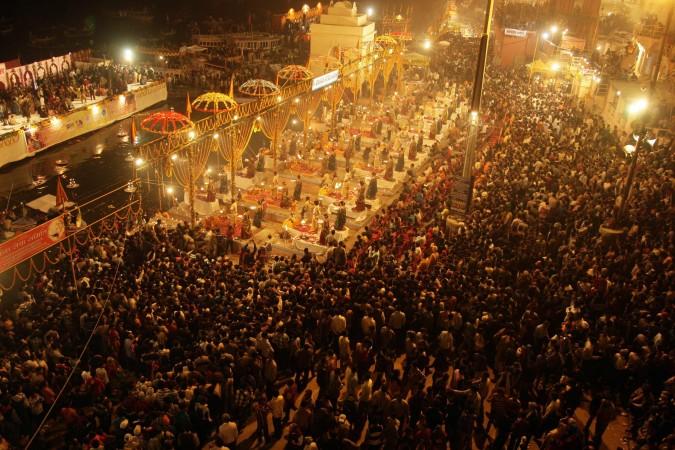
Dev Deepawali - © gather
Weather in Varanasi: Best Time to Visit
Varanasi experiences a subtropical climate with distinct seasonal variations, making it essential for travelers to understand the weather patterns to pack appropriately.
Average Temperatures
- Winter (November to February): Average temperatures range from 9.4°C (49°F) in January to 21.8°C (71°F). Nights can be cool, and fog is common, especially in December and January.
- Summer (March to June): This period is characterized by high temperatures, with averages reaching up to 40.5°C (105°F) in May. The heat can be intense, particularly in April and May.
- Monsoon (July to September): Average temperatures during this season range from 26.9°C (80°F) to 34.2°C (93°F). Rainfall is significant, especially in July and August, with July receiving around 260 mm (10.2 inches) of rain.
Rainfall
Varanasi receives an average annual rainfall of approximately 990 mm (39 inches), with the monsoon season from mid-June to early October being the wettest period. The driest month is typically December, with minimal rainfall.
Best Time to Travel
The best time to visit Varanasi is from mid-November to mid-February, when the weather is cooler and more comfortable for exploring the city's attractions. However, visitors should be aware that pollution levels can be high during this period.
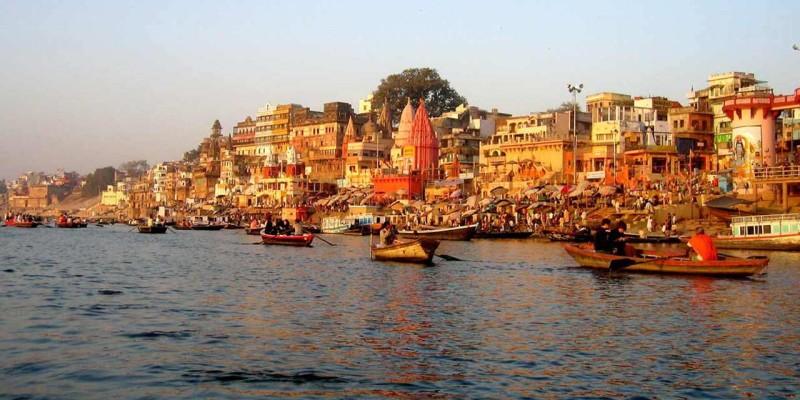
Dashashwamedh Ghat - © gather
Culture Etiquette in Varanasi
Dress Modestly
When visiting Varanasi, especially temples or religious sites, it's important for both men and women to wear clothing that covers shoulders, chest, and knees to respect local customs.
Remove Footwear
Always remove your shoes before entering temples or homes. Look for designated areas to store footwear as this practice is a sign of respect and cleanliness.
Respect Religious Practices
Varanasi is a hub of spiritual activity. Show respect for the city’s religious rituals, ceremonies, and the pilgrims, particularly along the vibrant ghats.
Photography Etiquette
Be mindful with your camera, especially at religious ceremonies or cremation ghats. Always ask for permission before photographing people, and adhere to local rules which might restrict photography in sacred areas.
Use of Right Hand
In Varanasi, it is customary to use your right hand for eating and for giving or receiving items, as the left hand is traditionally considered unclean.
Greetings
Greet people with a "Namaste" and folded hands, a respectful and widely accepted greeting throughout India.
Temple Etiquette
Inside temples, follow local customs such as walking clockwise around shrines and refrain from touching the idols to show respect.
Ganges Rituals
If you participate in any rituals along the Ganges, it’s prudent to follow the guidance of locals or religious leaders to respect traditional practices.
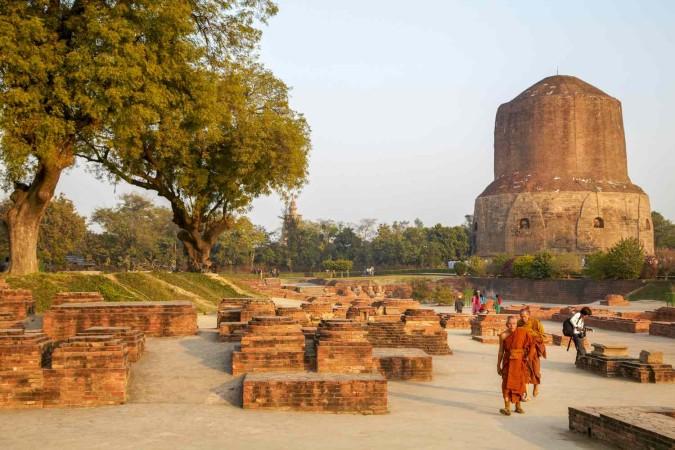
Sarnath - © gather
Essential Travel Information
Transportation
Airport Transfers
- Prepaid Taxi: Available at Lal Bahadur Shastri Airport, offering various vehicle options including Mini Cab, Micro Cab, Sedan Car, SUVs, and mini buses.
- Private Transfer Services: Companies like Suntransfers and Vidhan Travels offer pre-booked airport transfers with meet-and-greet services.
Taxis and Cab Services
- Local taxi services are available throughout the city.
- Prepaid taxi services can be booked online or via smartphone apps like Chiku Cab.
- Various vehicle options are available, from economy cars to luxury sedans and SUVs.
Articles for you

Experience Aboard The RV Indochine II - A Mekong Cruise With Tweet World Travel
The RV Indochine II is a luxury river cruise ship, offering an unforgettable journey through many attractions along the Mekong River. Built in 2017, this upscale vessel combines colonial elegance with modern conveniences to create a comfortable yet stylish environment for its crew and passengers. The ship’s intimate size makes it ideal for those seeking a more personal cruising experience while exploring Vietnam and Cambodia rich culture, scenery, and heritage. Whether you're gazing at the landscape from your private balcony or enjoying authentic local cuisine, RV Indochine II promises an exotic adventure like no other.

Witness Stilt Fishing In Sri Lanka: An Eco-Tourism Experience
Sri Lanka, renowned for its stunning beaches and rich cultural heritage, harbors a unique tradition that has captivated travelers for centuries: stilt fishing. This ancient practice, passed down through generations of coastal communities, blends artistry with necessity, offering a glimpse into a way of life intimately connected to the island's coastal rhythms. Stilt fishing in Sri Lanka isn't merely a means to catch fish; it's a cultural emblem, embodying the resilience and ingenuity of Sri Lanka's fishing communities.

Make Your Trip Stress-Free With The Tweet Trip App
Embark on your next adventure with confidence by downloading the Tweet Trip App, available for both iOS and Android. This essential travel companion allows you to view your detailed itinerary, stay connected with your tour guide and fellow travelers, receive real-time updates, and provide feedback effortlessly. With features like in-app messaging, emergency assistance, and location sharing, the Tweet Trip App ensures you travel smarter, stay connected, and enjoy a seamless, worry-free journey. Get started today and make the most of your travel experience with Tweet World Travel.

Pedal Through Paradise: Unveiling Cambodia's Hidden Gems on Two Wheels
The gentle whir of bicycle wheels mingles with the distant chants of monks as you glide past emerald rice paddies stretching to the horizon. This is Cambodia - a sensory explosion waiting to be experienced on two wheels. At Tweet Tours, we believe there's no better way to immerse yourself in the Kingdom of Wonder than by bicycle.
Cambodia isn't just a destination; it's a living, breathing tapestry of ancient wonders, natural beauty, and vibrant culture. Our carefully crafted cycling tours take you beyond the typical tourist haunts, offering a unique perspective on this captivating country. Ready to clip in and discover the magic of Cambodia? Let's ride!

Trekking in the Himalayas: A Journey Through Nepal's Majestic Peaks
The Himalayas rise from the earth like colossal guardians, their snow-capped peaks piercing the sky in a display of nature's raw power and beauty. Nepal, nestled at the heart of this mountain range, serves as the gateway to some of the most breathtaking trekking experiences on the planet. Here, the air is crisp and thin, filled with the promise of adventure and the whispers of ancient tales.
With Tweet Tours, as you set foot on these hallowed trails, you're not just a traveler - you're a modern-day explorer, following in the footsteps of legendary mountaineers and age-old traders. Each step takes you further into a world where nature reigns supreme and human resilience is tested against the backdrop of some of the world's highest peaks.
From the moment your boots touch the ground in Kathmandu, you'll feel the pull of the mountains. The bustling streets of the capital, with their sensory overload of sights, sounds, and smells, soon give way to serene mountain paths where the only soundtrack is the crunch of gravel underfoot and the distant tinkling of yak bells.

Exploring Mui Ne's Wonders: Unique Attractions & Local Dishes
Nestled along the southeastern coast of Vietnam, Mui Ne emerges as a captivating gem, blending natural wonders with cultural richness. Renowned for its stunning landscapes and unique attractions, Mui Ne beckons travelers seeking both relaxation and adventure in equal measure. Mui Ne's renowned beach dunes, bustling fishing towns, and excellent local food await exploration at every turn.
The allure of Mui Ne lies not only in its pristine beaches and crystal-clear waters but also in its diverse range of activities catering to every traveler's whims. Whether you're drawn to thrilling water sports like kitesurfing and windsurfing on its dynamic shores or seeking tranquility amidst the picturesque Fairy Stream, Mui Ne promises an unforgettable journey filled with discovery.
